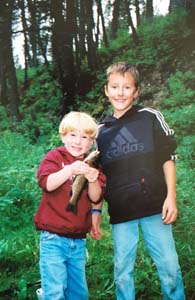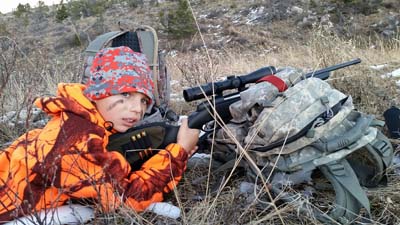POMA Intern
Aldo Leopold told us, “I am glad I will not be young in a future without wilderness.” A century later, in a country with 600 million acres of public land, it is not youth without wilderness, but wilderness without youth.
Many children no longer have the luxury of being “raised wild” by outdoor enthusiasts. Today’s young people are engrossed in mountains of 21st century distractions. The number of kids going to the mountains needs to grow. So, how do we get both youth and their parents involved and/or back in the outdoors?
 Photo by Ed Coyle Photography
Photo by Ed Coyle PhotographyStarting Them Off as Yearlings
Most outdoor adventurers have been going out with their dad, mom or grandpa since infancy. Ed Coyle’s children included, have backpacked on cross country ski trips, love to stream fish and are quite the shed finders. Hooking children young, while their time is still expendable is key. This will help them to choose to spend their time outdoors. With school sports, work, homework and friends, it takes an effort to put the outdoors first.
It starts with generating a sense of curiosity for the outdoors. “It’s so important for kids these days to connect with our outdoor surroundings, so that they can continue to learn about conservation,” says Ed. There are new ideas to try, but small changes to current opportunities are important.
How many hours a week do you spend in the car? Better yet, how are you using that time with your youngsters? Most will answer that they hand their kids a screen and don’t hear a peep until they reach their destination. This is a huge lost opportunity to get your offspring interested in what is outside. Turn the DVD off, put the iPhone away and ‘Make It A Game’. How many animals can each person see? Someone keep a tally of who spotted what, be it a bear in Yellowstone National Park or a blue jay on the way to school. Your child will go to school and share with all their friends what he or she saw outside. This is a far better learning tool than cartoons and games. Gas is no longer $4.00 a gallon, so this is not only something to do on the commute, but can also make Sunday drives a family experience.
Another right of outdoor passage is camping in the backyard. Getting used to the noises of the night is crucial in making first camping trips successful. After children sleep outside a couple of nights, they will be begging to go on a camping trip. They will probably ask to bring their friends along too.
 Photo by Ed Coyle Photography
Photo by Ed Coyle PhotographyContinuing Education with Cubs
Once youth reach school age, the outdoor opportunities only grow. It is up to the community, teachers and parents to ensure experiences are available. National Archery in the Schools (NASP), has been shown to increase participants’ outdoor interests. Shooting sports and outdoor activities also improve educational performance. This program extends a great experience to students who may otherwise never have an introduction to outdoor sports. It is then up to parents to fan the flame and keep the interest alive.
Montana, among many other states, has another school program called Hooked On Fishing. The program allows teachers to introduce fishing curriculum and equipment in their classrooms. These programs also include on water experience with Fish Wildlife and Parks’ employees. One teacher in the program had nothing but praise and was quoted with the following. “I found this program to be the single most influential experience my students were exposed to. They learned, they grew as students and they gained confidence as they experienced nature and developed new skills.”
 Not only can fishing become a lifelong sport for these students and their parents, but it can provide other opportunities. Students who pursue tournament fishing open many new scholarship availabilities and friendships.
Not only can fishing become a lifelong sport for these students and their parents, but it can provide other opportunities. Students who pursue tournament fishing open many new scholarship availabilities and friendships.Tournaments are not only great for participants, but for viewers as well. Next time your child asks you to play a fishing video game with them, don’t say no. Use the time with them to suggest that you should attend a real fishing tournament in your area. You’ll never see a child have as big a smile over a game, as they will with a real fish.
Outside of the usual school day is another form of education anyone interested in the outdoors should enroll in. Hunter and Bowhunter Education provide insight into the outdoors. Survival and safety skills taught in the course apply outside of hunting too. While many people who take Hunter Education plan to hunt, plenty do not. The course can invoke interest and teach weapon safety. You may also find mentors for yourself and your children.
 Pay It Forward
Pay It ForwardTeaching Hunter Education is volunteer activity for both adults and youth. I started teaching Hunter Education as a junior instructor. This allowed me to impact hundreds of students’ introduction to the outdoors. It has also given me a second family of outstanding mentors. I have found this group has not only taught me a lot about the outdoors, but many life skills as well. These skills include public speaking and messaging. All have been beneficial in my personal and professional life.
These dedicated volunteers include two Montanans who, for 60 years, have helped and continue to help the hunters of tomorrow. That’s right, this year two men received their 60-year service award from Montana Fish, Wildlife and Parks. They have been teaching Hunter Education since before it was mandated. This goes to show the power of dedication to conservation, the outdoors and hunting.
At Montana’s Hunter Education Convention, where these awards were given, we heard Randy Newberg speak. One item he spoke to is the message hunters and outdoorsmen portray through media. This message should be one of the value of the sport we love and why we live this lifestyle. With that in mind, instead of looking at social media in a negative light, make it a tool for getting youth outdoors. For under $100, you can purchase your child a digital camera to take on every outdoor adventure. Building a following is addictive and easy to do with a collection of outdoor images. A far more positive social presence than a lot of what is out there, for sure. Photography is a potential career path and extends the value of the outdoor experience. Your child doesn’t have to be the only one doing this either. Start a blog and you could post right alongside them.
 Playing Alongside Them
Playing Alongside ThemAnother piece of getting and keeping youth involved in the outdoors is mentorship. For the Spencer family, John, otherwise known as Dad is that mentor to sons Caleb and Jacob. Jacob started hunting with his brother, just tagging along without a license. Under the Apprentice Program, John was able to get Jacob a tag. When presented with the right chance, Jacob took his first 4x5 muley.
John says, “It is all about the boys and our time together, not the kill. It is their shot to take or not to take.” Both boys say it is about getting away from the daily grind and technology. Dad and the guys at camp provide stress-free fun. “Hunting and hunting camp is a lot of fun and you can provide food for your family,” Jacob said. Caleb chimed in to say that,“Through the Hunters for Hungry Program, you can donate your animals to families who don’t hunt or can’t afford food.” Both boys have donated a deer to this program, making John one proud dad.
For both longtime and new hunting parents, John says it is critical to get kiddos geared up right. “Shooting Grandpa’s .30-30 doesn’t work anymore.” A well-fitting youth model firearm and the safety knowledge of how to use it is a big deal for youngsters and their parents. “Cost can be a turnoff for new hunting families, but equipment can be shared and the memories are priceless”, says John.
While in many cases this is the mentorship scenario, finding youth mentors has draws for both sides as well. This is also a great way to get a child from a non-hunting family started. Having someone close to their age shows young ones that hunting isn’t only a sport for adults. Having a mentee is also a great experience for teens and young adults. Like any other sport, John says, “You have great teammates and a good coach”.
For Landyn, Brenden Novak is that mentor. Pictured with Brenden’s first archery bull taken last year, you can believe Landyn can’t wait for a tag of his own. To Landyn, Brenden is the hunter and outdoorsman he wants to be. It goes both ways too, as Brenden says, “Family is everything.”
Expand Your Family
Outside of your family are two great hunting families to be a part of; the National Wild Turkey Federation (NWTF) and the Rocky Mountain Elk Foundation (RMEF). Both organizations are a great place to find mentors for you and your kiddos. You can also contribute to the conservation of wildlife and public lands. RMEF President David Allen says, “We remain committed to ensuring the future of elk, other wildlife, their habitat and our hunting heritage. And who holds the keys to that future, if not our sons and daughters and grandchildren.” Both organizations, as well as many others, host youth hunting and volunteering events.
The options to get you and your youth outdoors are almost endless. I have mentioned only a few in this article. Ask your local Fish and Wildlife agency, talk to your children’s school teachers, visit a local sporting goods store or even post in your local classifieds. You will find that the majority of outdoorsmen and women are happy to help someone new into the world they love.
Closing Thought
Much could be said to end this piece, but I believe Fred Bear said it best. “Immerse yourself in the outdoor experience. It will cleanse your soul and make you a better person.”


